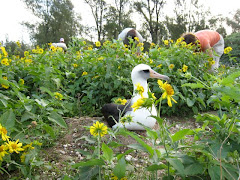 Ron started off with a “Guess how many spines on an urchin” guessing game, based on a question asked by one of his Ohio Kindergarten students. Terry came closest with 275! Ron reminded us that the total number of spines really depends on the species of urchin.
Ron started off with a “Guess how many spines on an urchin” guessing game, based on a question asked by one of his Ohio Kindergarten students. Terry came closest with 275! Ron reminded us that the total number of spines really depends on the species of urchin.We continued to learn about the cultural connections of first peoples in Hawai’i and the places we live. Ron specifically pointed out the traditional hunting and fishing grounds of Olympic Peninsula in Washington that were guaranteed by the Point-No-Point Treaty of 1856. The traditional subsistence fishing and hunting areas went from the coastline to the sea, similar to the Ahupua’a land divisions in Hawaii that were based on sustainable units that include fresh water, beach access, and ocean waters.
Terry helped us to learn traditional learning pedagogies that included the use of riddles and song! We all tried our hand at composing riddles about the things we have seen and experienced on Midway. Here’s a sample from Walterbea:
Here and there
we’re everywhere.
Without a care in the world.
Answer: marine debris
Terry also facilitated a traditional way of learning navigation without GPS or a compass. Hawaiians found their way to their destinations by making songs about the various waypoints along the way, using landmarks and stories. These were called traveling songs. We broke into groups and each made a traveling song about Midway Island.


















No comments:
Post a Comment